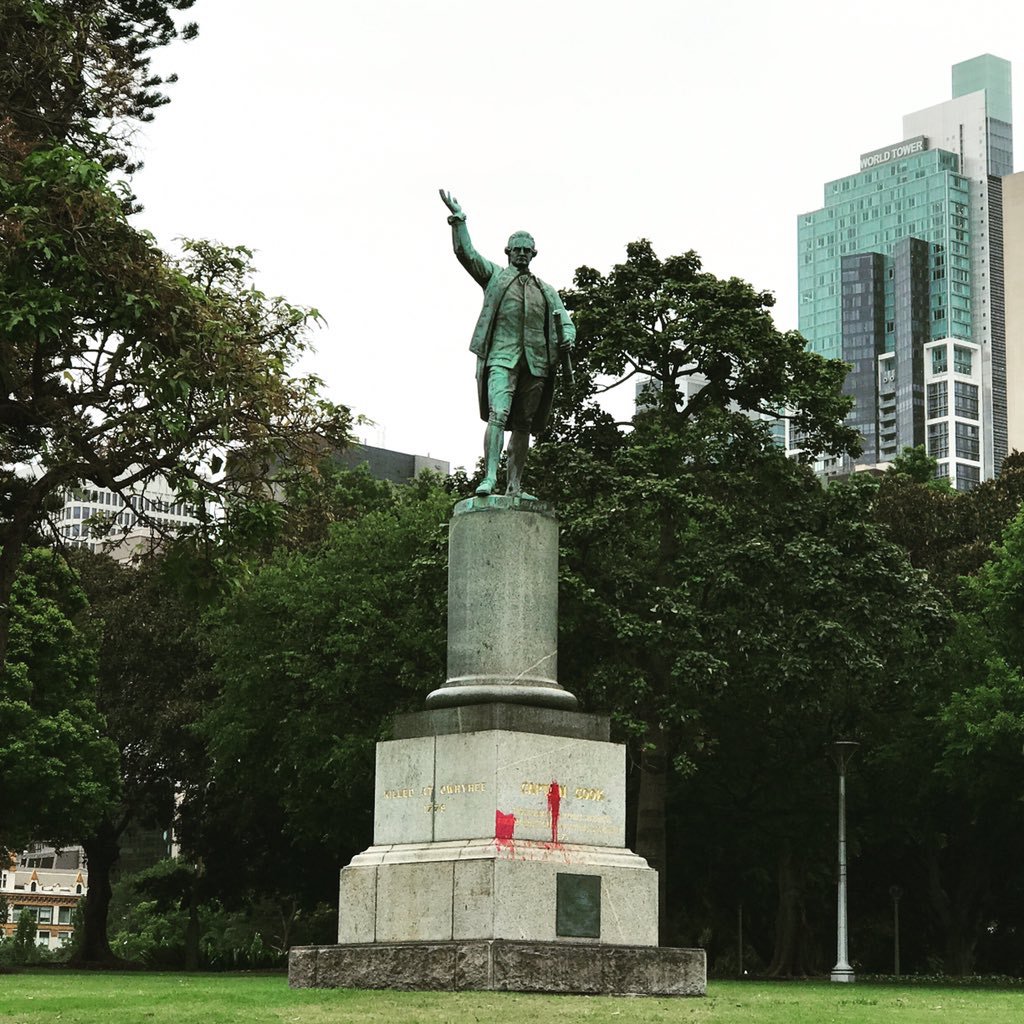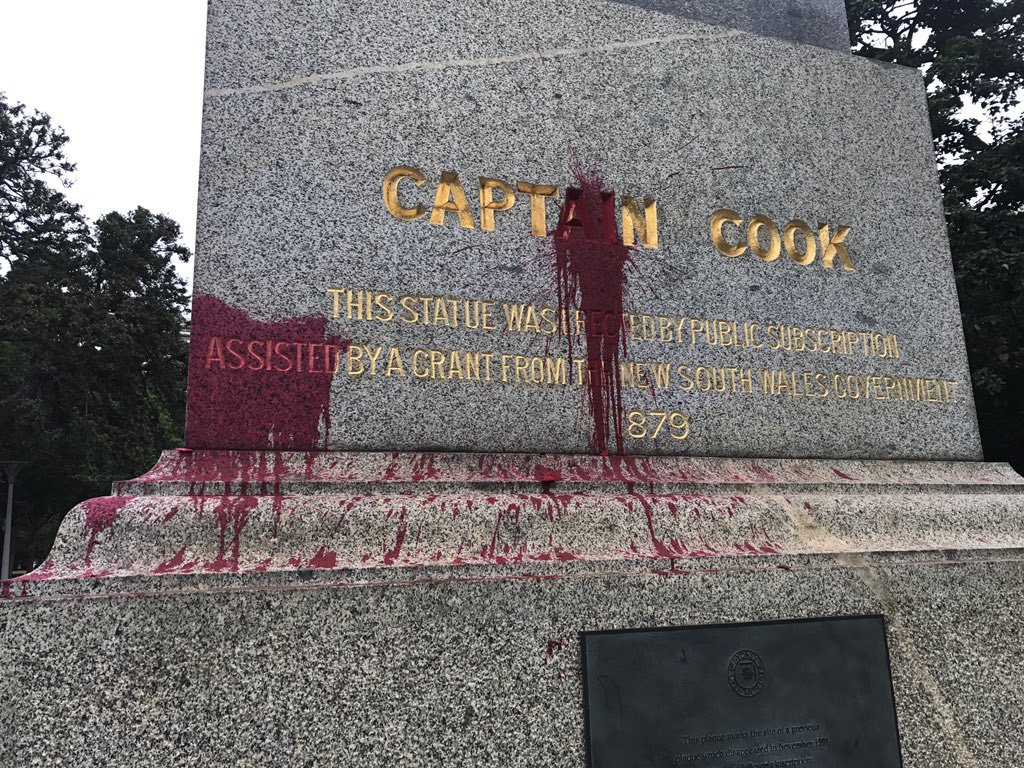Tear It Down
Dr Mariko Smith is a Yuin woman. She is a First Nations Assistant Curator at the Australian Museum and Honorary Associate in the School of Literature, Art and Media at the University of Sydney.
On this page...
How do we deal with false, constructed histories?
The glorification of Captain Cook and the denigration of Aboriginal people and culture has come to define the Australian national story and identity. Cook is heralded in school books, mainstream media, and monuments as the man who discovered and helped make Australia what it is today.
Although Cook died in 1779, well before the time Captain Arthur Phillip and the First Fleet arrived at Warrane (Sydney Cove) in January 1788 and the federation of the States and Territories in 1901, it is true that his expedition to the Pacific back in 1770 sowed the seeds of inspiration for voyage passengers Sir Joseph Banks’ and James Maria Matra’s proposals[1] for the establishment of a British colony in New South Wales.
Colonisation is part of a political system of control and power. The motivations for Banks’ and Matra’s proposals were around imperialism, accessing other lands’ resources and addressing social problems of late seventeenth century Great Britain (and incidentally also its American colonies), especially about the transportation of convicts.
Australia’s history is disproportionately centred on the British colonial history, which is but a small slice of time compared to the more expansive 60-plus thousand years of Aboriginal and Torres Strait Islander presence on these lands and waters.
Post-1770 history is used to obliterate and erase Aboriginal and Torres Strait Islander peoples’ rightful place as custodians of this land. This involved constructing a history which distorts the facts to suit an agenda of Terra Nullius, the “noble savage” and the “dying primitive race”.
False, constructed history, which ultimately stems from Cook and 1770, needs to be torn down at the foundations. From there, we can build a new shared history and future together. It is up to First Nations peoples to reclaim control of the narrative, to retell the story, and in doing so, reclaim our identity and rightful place in this country and this history.
This visual commentary by Gamilaroi multimedia artist Travis De Vries in his digital print Cook Falling, Tear it Down is a powerful example of confronting constructions of Australian history.

© Travis de Vries
In this digital image Cook Falling, Tear it Down (2019), which forms part of a graphic novel study by Gamilaroi artist Travis De Vries, we witness a scene in Hyde Park, Sydney – in a section not far from the site of the Australian Museum on College Street – where a group of Aboriginal people (wearing masks, depicted in Travis’ signature style) have tied a rope around the iconic yet often polarising statue of Captain Cook.
The focus of the image is on this powerful act of Aboriginal people physically pulling down the statue, and the distinctive pose mirrors a pivotal moment in history that also engages with iconic nationalism – in this instance, the raising of the American flag at Iwo Jima during the dying days of the Pacific theatre of World War II.
A point of difference highlighted by Travis in his image is that the pulling down of Cook here is about turning the idea of glorifying colonial regimes and celebrations of conquest into a form of empowerment for First Nations people. This is done through the tearing down of false idols and their history.
In Travis’ words:
- “A lot of the art that I make is not overtly political. There are elements of a political message, I just haven’t ever used art before to push my own political agenda. This work is very different and very much the same, at face value you are affronted with its meaning but that comes in the form of a deeply constructed narrative.”
- “In the work, the statue itself is graffitied with the words ‘Change the Date’ & ‘No Pride in Genocide’. This actually happened in 2017 when an unknown hero/ activist/ vandal/ scallywag (depending on who you ask) spray-painted the words onto the statue over the top of the engraved gold inlaid words which state Cook’s “discovery” in 1770 as part of the statue’s information. This came at a time when there were movements across the world about pulling down statues to stop celebrating colonisers and racists.”
- “The image is a study for a new graphic novel I am writing. It really was just a practice piece, however when I shared it with people they were excited because of the ideas shown and the potential that it represents. I wanted to work on the style and feel of the artwork. Figure out how I would depict backgrounds and objects, people and landscapes, what colours I would use and how they would help tell a story, so I picked a scene I had in my head that I could bring to life. You see the scene during the night time, illuminated by the lighting in the park.”
- “Thinking about this work not just as a single artwork but as a part of a larger story is what gives it so much power; the tearing down of a statue isn’t an easy act. It’s a part of a large narrative following multiple people and perspectives. There would have been planning and there would have been emotions; fear, anger and hope. This work has big themes. One of retelling and reclaiming control and who owns that control, reclaiming an identity that is a big part of that story.”

© Megan Lawrence

© Megan Lawrence
References
[1] See for example Banks’ testimony to the Bunbury Committee, 10 April 1779, Journal of the House of Commons, Volume 37, p. 311; and Matra’s ‘Proposal for Establishing a Settlement in New South Wales', 1783 and Matra’s ‘Supplement to his New South Wales Proposal’, 6 April 1784, in Historical Records of New South Wales (Government Printer 1892) [HRNSW] Vol. I, Part 2, p. 6.

